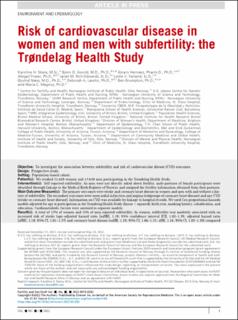| dc.description.abstract | Objective
To investigate the association between subfertility and risk of cardiovascular disease (CVD) outcomes.
Design
Prospective study.
Setting
Population-based cohort.
Patient(s)
We studied 31,629 women and 17,630 men participating in the Trøndelag Health Study.
Intervention(s)
Self-reported subfertility. As men were not directly asked about fertility, male partners of female participants were identified through linkage to the Medical Birth Registry of Norway and assigned the fertility information obtained from their partners.
Main Outcome Measure(s)
The primary outcomes were stroke and coronary heart disease in women and men with and without a history of subfertility. The secondary outcomes were myocardial infarction and angina (subgroups of coronary heart disease) and any CVD (stroke or coronary heart disease). Information on CVD was available by linkage to hospital records. We used Cox proportional hazards models adjusted for age at participation in the Trøndelag Health Study (linear + squared), birth year, smoking history, cohabitation, and education. Cardiometabolic factors were assessed in separate models.
Result(s)
A total of 17% of women and 15% of men reported subfertility. In women, subfertility was modestly associated with an increased risk of stroke (age-adjusted hazard ratio [aaHR], 1.19; 95% confidence interval [CI], 1.02–1.39; adjusted hazard ratio [aHR]; 1.18; 95% CI, 1.01–1.37) and coronary heart disease (aaHR, 1.19; 95% CI, 1.06–1.33; aHR, 1.16; 95% CI, 1.03–1.30) compared with fertile women. In men, we observed a weak positive association for stroke (aaHR, 1.11; 95% CI, 0.91–1.34; aHR, 1.10; 95% CI, 0.91–1.33) and a weak inverse association for coronary heart disease (aaHR, 0.92; 95% CI, 0.81–1.05; aHR, 0.93; 95% CI, 0.81–1.06).
Conclusion(s)
We observed modestly increased risks of CVD outcomes in women and some weak associations in men, although with no strong statistical evidence on sex differences. We acknowledge that we were only able to include men linked to pregnancies ending at 12 completed gestational weeks or later, potentially resulting in selection bias and misclassification of history of subfertility in analyses of male partners. Despite the large sample size, our results indicate the need for larger studies to obtain precise results in both sexes and determine whether there are true sex differences. | en_US |

